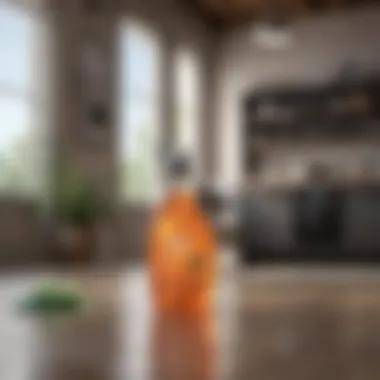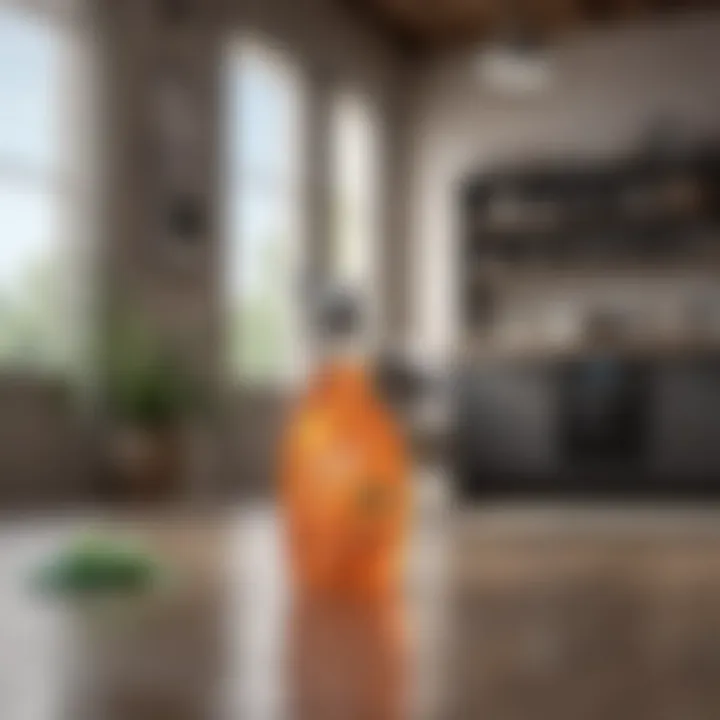Sanitize Your Home: A Comprehensive Guide


Intro
Maintaining a sanitized home environment is essential for both the aesthetics and health of its inhabitants. Cleanliness reduces the risk of illness, allergen exposure, and promotes overall mental well-being. This article aims to delve into best practices for sanitizing various aspects of the home. This includes understanding the significance of cleanliness, recognizing the different surfaces and materials that need specific attention, and utilizing the right tools for effective sanitization.
A comprehensive approach will be taken to discuss various methods suited for different areas within the home. The readers will gain insights that can empower them to create a healthier living space. The focus remains on practical applications and easy-to-follow techniques that can be adapted to various lifestyles.
Architectural Inspiration
Sanitization may not directly relate to architectural design, yet the inspiration drawn from design philosophies can influence how we maintain cleanliness. Known for their functionality and adaptability, modern design trends emphasize open spaces and natural light, creating an inviting atmosphere. In this context, it is crucial to consider how the design elements relate to sanitation practices.
Overview of Design Styles
Minimalism: This style advocates for simplicity, which often leads to less clutter, making it easier to maintain clean spaces. The fewer items present in a home reduce the areas where germs and dirt can accumulate.
Scandinavian Design: Characterized by its emphasis on bright colors and natural elements, Scandinavian design can also enhance hygienic practices. The use of materials like wood and textiles necessitates specific cleaning methods to ensure longevity and maintain beauty.
Innovative Materials and Techniques
Modern innovations have led to materials that actively resist dirt and bacteria. For instance, nano-coatings can be applied to surfaces to create a barrier against contaminants. Additionally, the integration of antimicrobial surfaces in household items promotes easier cleaning and better hygiene. Knowing how to sanitize these advanced materials effectively is crucial for homeowners.
Interior Design Trends
Understanding the intersection of design trends and sanitization practices can significantly enhance a workplace or living environment. The choices made here not only reflect personal style but also influence the frequency and methods of cleaning.
Color Schemes and Their Psychological Effects
Colors can subconsciously affect mood and perceptions of cleanliness. For example, lighter colors tend to promote a sense of openness and cleanliness, while darker hues can sometimes give the opposite impression. Incorporating colors that evoke cleanliness can positively influence the motivation to maintain a sanitized home.
Space Optimization Tips
An organized home not only looks better but can also enhance sanitary practices. Here are some space optimization tips:
- Use multi-functional furniture: This helps minimize clutter.
- Install built-in storage: Allows for a cleaner look and easier access to cleaning supplies.
- Create designated cleaning zones: Designating areas for specific items can help streamline cleaning routines.
A well-designed space can significantly reduce the effort needed to maintain hygiene.
In sum, understanding architectural styles and interior trends lays the groundwork for effective sanitization practices. By merging aesthetic preferences with cleanliness, homeowners can create spaces that are not only visually pleasing but also prioritize health.
Understanding Hygiene and Sanitation
Hygiene and sanitation are critical components of maintaining a healthy living environment. They encompass practices that promote cleanliness and prevent the spread of disease-causing organisms. Understanding these concepts is integral not only for the well-being of individuals but also for the collective health of communities. This section aims to clarify the definitions and underline the necessity of proper sanitation practices within the home.
Definition of Hygiene
Hygiene refers to conditions and practices that help to maintain health and prevent the spread of diseases. This concept includes personal hygiene, such as handwashing, bathing, and oral care, as well as environmental hygiene, which pertains to the cleanliness of living spaces. Good hygiene practices reduce the number of pathogens present and can significantly deny their ability to spread. Incorporating hygiene into daily life involves everyday decisions and habits that prioritize cleanliness and health.
Importance of Sanitation
Sanitation is the process of ensuring that environments are free from harmful elements, such as pathogens and contaminants. The importance of sanitation cannot be overstated. Effective sanitation practices contribute to:
- Health improvement: Regular sanitization reduces the risk of infections and diseases, which is crucial in preserving health for families.
- Enhanced quality of life: Clean surroundings lead to improved mental well-being and comfort within the home.
- Prevention of pest infestations: Proper sanitation deters pests, which are often carriers of diseases.
- Sustainability practices: Establishing good sanitation habits can contribute to broader environmental health, minimizing pollution and waste.
"Preventive health practices are far more effective than reactive measures in ensuring long-term well-being."
By recognizing the significance of hygiene and sanitation, individuals become more equipped to establish routines that foster a safe and healthy living space. Understanding the overlap between these elements allows for informed decision-making regarding cleaning and sanitizing methods.
Identifying High-Touch Areas
Identifying high-touch areas within a home is a fundamental aspect of maintaining a healthy living environment. These areas are frequently contacted by individuals, making them potential hotspots for germs and bacteria. Understanding where these surfaces are located and how often they are touched can significantly impact the effectiveness of sanitization efforts. The benefits are twofold: first, targeted cleaning saves time and resources; second, it reduces the risk of contaminating other areas in the home. Thus, recognizing high-touch zones is not just beneficial but critical in ensuring comprehensive hygiene protocols are adhered to.
Common High-Touch Surfaces
High-touch surfaces generally include various items and areas that people interact with regularly. Some of the most common high-touch surfaces in a home are:
- Doorknobs and Handles: Often touched when entering or exiting, these areas can harbor numerous pathogens.
- Light Switches: Frequently operated throughout the day, these can become breeding grounds for germs.
- Counters and Tabletops: These surfaces see constant contact, whether during meal preparation or daily activities.
- Bathroom Fixtures: Faucets and toilet handles are touched after washing hands, making them critical areas for sanitization.
- Remote Controls and Electronics: Items like TV remotes or mobile devices are frequently used, providing a direct path for germs to transfer.
- Refrigerator and Oven Handles: Used several times a day to access food, they require regular cleaning.


Keeping these surfaces sanitized not only improves the overall cleanliness of a home but also minimizes the possibility of illness. Special attention should be given to these areas during cleaning routines.
Assessing Your Living Space
To effectively identify high-touch areas, a thorough assessment of your living space is necessary. Take time to visualize how different rooms are used within a daily routine. Consider the following:
- Traffic Patterns: Observe which rooms see the most traffic and what surfaces get touched the most. Kitchen and living areas are usually high-traffic spots.
- Activity Zones: Recognize areas where family members gather and the surfaces within them. For example, the dining table is a high-touch area during meal times.
- Personal Items: Items that are handled frequently, such as keys or handbags, should also be considered during a sanitization plan.
Incorporating these insights allows for a customized sanitation strategy. Keeping a documented list of high-touch areas can aid in creating a consistent and effective cleaning routine. A focused approach ensures that your home remains a safe and healthy environment.
Sanitization Methods
Sanitization methods are crucial in ensuring a clean and healthy environment in any home. These techniques not only eliminate harmful bacteria and viruses but also maintain a sense of order and comfort. Understanding the various sanitization methods empowers homeowners to make informed decisions about cleaning. It is essential to integrate effective procedures into regular cleaning routines. This approach not only enhances the aesthetic appeal of living spaces but also contributes to overall well-being by reducing health risks associated with germs.
Disinfectants and Sanitizers
Disinfectants and sanitizers play a key role in home hygiene. Disinfectants are chemical agents designed to destroy a wide range of pathogens. They are ideal for surfaces in kitchens and bathrooms where germs thrive. Common examples of disinfectants include bleach, hydrogen peroxide, and commercial cleaners like Lysol. On the other hand, sanitizers reduce the level of germs but do not necessarily kill them all. Products with lower concentrations can be effective on lightly soiled surfaces and in less critical areas of the home.
When using disinfectants and sanitizers, it is important to follow directions on the label. Proper application usually entails cleaning the surface first to remove any dirt. After cleaning, apply the disinfectant and allow it to sit for the recommended time. This dwell time is crucial for effectiveness against microbes. Remember to ensure good ventilation in the area, as fumes from these products can be harmful in enclosed spaces.
Steam Cleaning and Its Benefits
Steam cleaning emerges as an effective method for sanitizing various surfaces. This process utilizes high-temperature steam to eliminate germs without harsh chemicals. Steam can penetrate small crevices, ensuring a thorough clean. It is especially effective on hard surfaces like tile, laminate, and hardwood floors, as well as upholstery.
The benefits of steam cleaning extend beyond just sanitization. It can also remove stubborn stains, making it a versatile cleaning option. Additionally, steam cleaning helps reduce allergens, providing a healthier indoor air quality. While it requires a steam cleaner, the investment can be economical in the long run, considering its efficiency and effectiveness in maintaining a clean home environment.
Natural Cleaning Solutions
For those who prefer eco-friendly approaches, natural cleaning solutions offer an attractive alternative. These solutions often rely on common household ingredients like vinegar, baking soda, and lemon juice. Each of these has unique properties that can help in cleaning and sanitizing.
- Vinegar is an effective disinfectant and can cut through grease.
- Baking soda works well as a mild abrasive and deodorizer.
- Lemon juice has antibacterial qualities and leaves a fresh scent.
Using natural ingredients minimizes exposure to harmful chemicals. Moreover, they are generally less expensive than commercial cleaning products. However, it's important to understand that natural solutions may not be as effective against all types of pathogens. Therefore, they should complement other cleaning methods for a comprehensive hygiene strategy.
Remember, while sanitizing your home, the goal is to create a safe environment that enhances health and well-being, allowing for a comfortable living experience.
The Role of Personal Protection Equipment
Personal Protective Equipment, often referred to as PPE, plays a critical part in maintaining safety and health during sanitization processes at home. When individuals engage in cleaning activities, especially those involving strong chemicals or significant dirt, wearing the appropriate PPE can mitigate health risks. This section outlines both the types of PPE essential for household cleaning and the correct ways to use them effectively.
Types of PPE for Household Cleaning
In a household cleaning context, several categories of PPE are vital. Here are key types to consider:
- Gloves: Disposable or reusable gloves protect the skin from harsh chemicals, allergens, and potential irritants. Nitrile gloves are favored due to their durability and sensitivity, making them ideal for tasks requiring dexterity.
- Masks: Respiratory protection, such as N95 or surgical masks, helps filter out harmful particles from cleaning agents or dust. This is particularly important in enclosed spaces where fumes can build up.
- Goggles: Eye safety is crucial when using potent cleaners that may splash. Goggles prevent chemical exposure to the eyes and safeguard against any debris while cleaning.
- Aprons or Coveralls: Protecting your clothing and skin from spills and stains is also important. Wearing an apron or a full coverall can provide an additional layer of protection while performing your cleaning duties.
In summary, these various types of PPE are not only useful. They are essential in ensuring a safer cleaning environment and help in avoiding health complications.
Proper Use of PPE
Correct usage of PPE is equally important as its selection. Here are guidelines to follow for maximizing the effectiveness of PPE in household cleaning tasks:
- Inspect Before Use: Always check your PPE for any damage or defects. This ensures that gloves and masks provide the protection intended.
- Wear Correctly: Follow the manufacturer's instructions on how to wear each piece of PPE. For example, secure masks fully over your nose and mouth and ensure goggles fit snugly against your face.
- Change Regularly: Single-use items like gloves and masks should be replaced frequently, especially when cleaning larger areas, to maintain their protective properties.
- Clean After Use: If using reusable items, ensure they are cleaned and disinfected correctly after each use. This practice extends their lifespan and ensures they remain safe for future tasks.
- Store Safely: After cleaning, store your PPE in a clean, dry area to prevent contamination. Avoid damp or crowded spaces to maintain their condition.
By understanding the vital role of PPE in the sanitization process and adhering to proper usage guidelines, individuals can significantly reduce the risks associated with home cleaning tasks. Always prioritize safety to ensure an effective and healthy cleaning experience.
Specific Areas to Focus On
When we talk about home sanitation, certain areas demand our attention more than others. These specific regions often harbor the most germs and bacteria, making their upkeep critical not only for hygiene but also for overall well-being. Targeting these areas with consistent and effective cleaning practices can lead to noticeable improvements in your living environment.
Kitchens: A Zone of Focus
The kitchen is undeniably the heart of the home. It's where we prepare our meals, and in many cases, it serves as a gathering spot for families. Because of its intensive use, this area requires consistent sanitization. The kitchen countertop, sink, and appliances are often prone to contamination from foodborne bacteria.
To maintain a clean kitchen, focus on high-touch surfaces such as cabinet handles and refrigerator doors. Regularly disinfect these areas with appropriate cleaning agents.
- Cleaning Method: Use a sanitizing solution on countertops after every meal preparation. This should not only remove bacteria but also prevent cross-contamination.
- Frequency: Daily effectiveness is key. Set a routine that includes cleaning often-forgotten spots like the microwave interior, as well as drains and dishwashing sinks.


Bathrooms: Ensuring Sterility
Bathrooms are a hotspot for germs and bacteria. The constant moisture and warmth create an ideal environment for microorganisms to thrive. Regular sanitation thus becomes essential in ensuring sterility.
Focus on the toilet, sink, and shower areas. Utilize disinfectant wipes on bathroom surfaces, including faucets and flush handles.
- Cleaning Supplies: Opt for products that explicitly indicate their effectiveness against common pathogens.
- Routine: Aim for bi-weekly deep cleaning, while maintaining a daily surface cleaning habit to manage germs you may not see.
Living Areas: Dust and Germ Management
Living areas are often a catch-all for dust, pet dander, and various germs. These spaces need to be kept clean to support a healthy environment. Regular vacuuming and dusting can drastically reduce allergens and bacteria.
Concentrate on surfaces such as coffee tables, remote controls, and light switches, which can often be overlooked.
- Routine Actions: Include dusting shelves and electronics as part of your weekly cleaning.
- Air Quality: Facilitate better air quality by reviewing HVAC filters; consider using air purifiers to eliminate harmful particles.
"Consistent cleaning in targeted areas can greatly lessen the spread of harmful germs in your home."
Developing a Cleaning Routine
Creating a cleaning routine is crucial in maintaining a sanitized and healthy home. It brings structure to cleaning tasks, allowing homeowners to manage their time efficiently while ensuring that every area of the house receives appropriate attention. Moreover, an established routine minimizes the accumulation of dirt, germs, and allergens, ultimately leading to a more pleasant living environment.
A well-defined cleaning schedule helps in breaking down tasks into manageable segments. This approach reduces the overwhelming feeling that often comes with cleaning extensive spaces. By organizing tasks daily, weekly, and monthly, residents can maintain optimal cleanliness without excessive effort or time commitment.
Daily, Weekly, and Monthly Tasks
Breaking cleaning tasks into daily, weekly, and monthly duties creates a balanced approach to home maintenance.
- Daily Tasks:
- Weekly Tasks:
- Monthly Tasks:
- Wipe down high-touch surfaces like doorknobs, light switches, and remote controls.
- Sweep or vacuum high-traffic areas to control dirt and pet hair.
- Do the dishes and clear kitchen counters to prevent buildup.
- Make beds and tidy up living spaces for a fresh feel.
- Mop floors and vacuum carpets in thorough detail.
- Sanitize bathroom sinks, toilets, and tubs, focusing on areas that harbor bacteria.
- Dust surfaces such as shelves, baseboards, and blinds to eliminate allergens.
- Change bed linens and towels to maintain freshness.
- Deep clean appliances like refrigerators and ovens.
- Organize closets and donation items to declutter the home.
- Wash windows and wipe down light fixtures for a polished look.
- Inspect and clean less frequently used areas, like the garage or attic.
Each frequency of cleaning contributes significantly to a more manageable and efficient routine.
Creating a Sustainable Plan
A sustainable cleaning plan integrates eco-friendly practices that benefit both the home and the environment. Consider the following elements for a sustainable approach:
- Choose Green Products: Look for eco-friendly cleaning products that do not contain harmful chemicals, thus reducing environmental impact.
- DIY Cleaning Solutions: Create homemade cleaners using simple ingredients like vinegar or baking soda. This option is often cost-effective and minimizes waste.
- Reduce Waste: Implement strategies such as using washable cleaning cloths instead of paper towels. Avoid single-use plastics when possible.
- Create a Schedule: Regularly review and adjust the cleaning plan based on effectiveness and convenience. Flexibility is key in ensuring long-term commitment.
Maintaining a clean home should never compromise environmental health. Opting for sustainable cleaning practices not only safeguards personal well-being but contributes positively to the world as a whole.
"Sustainability in cleaning practices is not just a trend; it's a necessity for a healthier life and planet."
The Impact of Pets on Home Sanitation
Pets add joy and companionship to our lives, but they also introduce unique challenges in maintaining a clean and healthy home environment. Understanding how pets impact sanitation is vital for any homeowner, especially those with allergies, respiratory conditions, or young children. Pets can spread dander, fur, and even pathogens throughout the home, necessitating a proactive approach to cleanliness. By understanding these factors, pet owners can make informed choices to ensure both their pets and homes remain healthy.
Managing Pet Hygiene
To effectively maintain pet hygiene, it is crucial to establish a consistent routine. Regular grooming helps minimize shedding and allergens in the home. Brushing your pet weekly or more frequently, depending on the breed, can significantly reduce the amount of fur and dander dispersed into your living space. Additionally, bathing your pet on a regular basis can eliminate odors and further control allergens.
When dealing with pet hygiene, cleanliness of pet bedding is often overlooked. Washing pet beds, blankets, and toys frequently can help eliminate bacteria and odors. Ideally, these items should be washed every two weeks, or more often if the pet has allergies or skin conditions.
It is also important to consider the diet and health of pets. A balanced diet can contribute to a healthy coat, while regular veterinary check-ups can identify potential skin issues early.
Cleaning up After Pets
Cleaning up after pets is essential to maintaining home sanitation. This not only includes picking up after them but also ensuring that areas of the home where they frequent are regularly cleaned. Here are some effective practices for a cleaner living space:
- Vacuum Regularly: Use a vacuum designed for pet hair to capture dander and allergens from floors and furniture.
- Mop Floors: After vacuuming, mopping hard floors removes any remaining dirt and allergens. A mild disinfectant can be included to further sanitize the surfaces.
- Spot Clean Accidents Promptly: Accidents can happen, especially with young pets. Cleaning up messes quickly helps prevent odors and stains. Use an enzymatic cleaner specifically designed for such situations to break down organic materials and eliminate lingering smells.
"Regular cleaning ensures that both pets and humans can enjoy a harmonious living space without health risks."


By integrating these practices, pet owners can significantly improve their home's sanitation. Pets, while important members of the family, should be managed in such a way that their presence does not compromise the health and comfort of the household.
The Science of Germs and Bacteria
Understanding germs and bacteria is crucial when discussing home sanitation. This knowledge contributes to effective cleaning practices, which ultimately protect the health of those living in the home. Germs can be defined broadly as microorganisms that include bacteria, viruses, fungi, and protozoa. Many are harmless, but some can cause illness. Therefore, acknowledging which germs are present and how they exist is essential to maintain a safe home environment.
Understanding Germ Life Cycles
Germs can exist in various forms and have distinct life cycles. Bacteria can reproduce quickly, sometimes within 15 to 30 minutes under the right conditions. Knowing this helps in prioritizing areas that require more frequent cleaning. Additionally, some bacteria form spores, temporary protective structures that can survive harsh conditions. These spores can remain dormant for long periods but can become active once favorable conditions return.
In any home, warm, moist areas tend to support the life cycles of germs effectively. For example, bathrooms and kitchens create an ideal setting due to potential food sources and moisture availability. Understanding such cycles helps in identifying high-risk areas needing attention and effective sanitation methods. Properly using disinfectants at the right time increases the probability of destroying harmful germs during their active phases.
How Germs Spread in Homes
Germs can spread through touch, airborne particles, or surfaces. Touch is the primary mode of transmission; when one person touches a contaminated surface and then their face, they can transfer germs. This route is particularly concerning for high-touch areas such as doorknobs, light switches, and faucet handles.
Airborne transmission is another significant method. Germs can be expelled into the air when a person coughs, sneezes, or even talks.
To minimize the spread, consider the following strategies:
- Regularly disinfect high-touch surfaces.
- Use hand sanitizers where soap and water are not available.
- Encourage proper handwashing techniques.
Implementing these practices not only reduces germ spread but also promotes a healthier living environment.
"An ounce of prevention is worth a pound of cure."
Sustainability in Cleaning Practices
Embracing sustainability in cleaning practices is increasingly crucial in today's world. As concerns about environmental degradation rise, so does the need for households to adapt their methods. Sustainable cleaning is not merely an option but a responsibility. Using eco-friendly products helps minimize the ecological footprint while also ensuring a healthier living environment. This section examines the specific elements that underpin sustainable cleaning practices and their tangible benefits.
Eco-Friendly Products
Eco-friendly products can significantly transform cleaning routines. These items often contain natural ingredients, minimizing harmful chemicals that can affect both health and the environment. Some widely recognized eco-friendly products include brands like Seventh Generation and Method. These brands focus on biodegradable materials and non-toxic formulations.
Utilizing eco-friendly products provides various benefits, such as:
- Reduction of Indoor Air Pollution: Conventional cleaning agents can release volatile organic compounds (VOCs), which may contribute to respiratory issues or allergies. Eco-friendly alternatives help mitigate these risks.
- Safety for Children and Pets: With reduced harmful chemicals, households with young children or pets can clean without the worry of accidental exposure to toxins.
- Biodegradability: Many sustainable products break down naturally and don’t contribute to landfill waste.
Despite potential higher costs, eco-friendly options may prove more economical in the long run by contributing to better health and environmental conservation.
Minimizing Waste and Pollution
Minimizing waste and pollution encompasses various strategies essential for sustainable cleaning. The primary goal should be to reduce single-use items, seek recycling options, and avoid products that add to environmental burdens.
Practical methods for minimizing waste include:
- Reusable Cleaning Tools: Microfiber cloths and mop pads can be washed and reused multiple times, unlike disposable wipes that contribute to landfill waste.
- Bulk Purchasing: Buying cleaning supplies in bulk reduces packaging waste and often proves more economical. Many stores now offer refill stations for popular eco-friendly cleaning products.
- Homemade Cleaning Solutions: Making cleaning solutions from everyday items like vinegar, baking soda, and lemon helps save money and eliminates concern about harmful ingredients.
By adopting these sustainability practices, households can significantly lessen their environmental impact. Consider focusing on both the immediate cleaning tasks while keeping a long-range view of how these practices contribute to the health of the planet.
"Sustainable living is not a trend, it is a necessity for the future of our health and ecology."
Ultimately, implementing sustainable cleaning practices enhances not only personal health but also the wellbeing of the ecology. This connection between cleanliness and sustainability should serve as a guiding principle in how one approaches home sanitation.
End: The Path Forward
In the context of sanitizing your home, the conclusion serves as a critical reflection on what has been discussed throughout this guide. Sanitizing your living space is not merely a task; it is a commitment to health and well-being. Understanding the importance of regular cleaning routines and targeted sanitization can significantly reduce the presence of harmful bacteria and germs in your home.
This article has outlined various key strategies that contribute to effective home sanitation. These strategies educate homeowners on the significance of maintaining a clean environment, not only for aesthetics but also for overall health. The simple act of cleaning surfaces, regularly sanitizing high-touch areas, and using the right products can make a notable difference in your living space.
Recap of Key Strategies
When reviewing the main points discussed, several strategies emerge as essential:
- Identifying high-touch areas: It is crucial to assess the surfaces and areas in your home that garner the most contact, such as doorknobs, light switches, and remote controls. Targeting these areas ensures that your cleaning efforts are effective.
- Utilizing the appropriate sanitization methods: Different surfaces require distinct approaches. Using disinfectants effectively on hard surfaces and opting for natural cleaning solutions on delicate materials can enhance the sanitization process.
- Incorporating a cleaning routine: Developing a structured routine that includes daily, weekly, and monthly tasks allows for consistent management of hygiene. This approach also minimizes overwhelming cleaning days.
- Adapting to the influence of pets: Pets can introduce additional challenges, but managing their hygiene and cleaning up after them is invaluable for maintaining a sanitized home.
- Embracing eco-friendly practices: As discussed, sustainable cleaning products not only help in minimizing environmental impact but also promote a healthier indoor air quality.
The Ongoing Journey of Home Sanitation
The journey of maintaining a sanitized home is continuous. It requires adapting to changes in your living environment and being mindful of practices that keep your space healthy. Regularly reassessing your cleaning methods and products ensures that you remain informed about the latest in hygiene science.
Moreover, the impact of your sanitization efforts extends beyond your household. By setting an example, you contribute to a culture of cleanliness within your community. The knowledge gained here can be shared with family and friends, amplifying a broader understanding of the significance of home sanitation.
"Home sanitization is an ongoing effort that adapts according to lifestyle changes, home dynamics, and emerging health needs."







